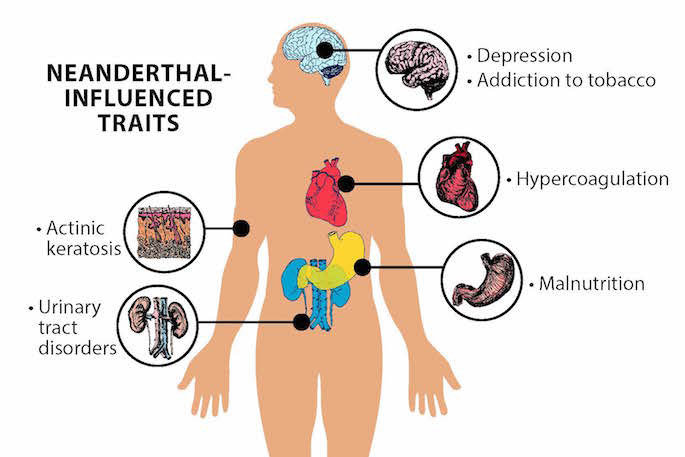The discovery spawned a number of hypotheses about the effects these genetic variants may have on the physical characteristics or behavior of modern humans, ranging from skin color to heightened allergies to fat metabolism—and generated dozens of colorful headlines including "Neanderthals are to blame for our allergies" and "Did Europeans get fat From Neanderthals?"
Now, scientists have conducted the first study to directly compare Neanderthal DNA in the genomes of a significant population of adults of European ancestry with their clinical records.
The findings not only confirm that this archaic genetic legacy has a subtle but significant impact on modern human biology—but they also turn up some surprises.
"Our main finding is that Neanderthal DNA does influence clinical traits in modern humans," says John Capra, assistant professor of biological sciences at Vanderbilt University. "We discovered associations between Neanderthal DNA and a wide range of traits, including immunological, dermatological, neurological, psychiatric, and reproductive diseases."Some of the associations that the researchers found confirm previous hypotheses. One example is the proposal that Neanderthal DNA affects cells called keratinocytes that help protect the skin from environmental damage such as ultraviolet radiation and pathogens.
The new analysis found Neanderthal DNA variants influence skin biology in modern humans, in particular the risk of developing sun-induced skin lesions called keratosis, which are caused by abnormal keratinocytes.
They also found that a specific bit of Neanderthal DNA significantly increases risk for nicotine addiction. A number of variants influence the risk for depression: some positively and some negatively. In fact, a surprisingly number of snippets of Neanderthal DNA are associated with psychiatric and neurological effects, the study shows.
"The brain is incredibly complex, so it's reasonable to expect that introducing changes from a different evolutionary path might have negative consequences,"says doctoral student Corinne Simonti, the paper's first author.
28,000 Patients
The pattern of associations the researchers discovered suggest today's population retains Neanderthal DNA that may have provided modern humans with adaptive advantages 40,000 years ago as they migrated into new non-African environments with different pathogens and levels of sun exposure. However, many of these traits may no longer be advantageous in modern environments.
One example of this is a Neanderthal variant that increases blood coagulation.
It could have helped our ancestors cope with new pathogens encountered in new environments by sealing wounds more quickly and preventing pathogens from entering the body. In modern environments this variant has become detrimental, because hypercoagulation increases risk for stroke, pulmonary embolism, and pregnancy complications.
To discover these associations, the researchers used a database containing 28,000 patients whose biological samples have been linked to anonymized versions of their electronic health records. The data came from eMERGE— the Electronic Medical Records and Genomics Network funded by the National Human Genome Research Institute— which links digitized records from Vanderbilt University Medical Center's BioVU databank and eight other hospitals around the country.
This data allowed the researchers to determine if each individual had ever been treated for a specific set of medical conditions, such as heart disease, arthritis, or depression.
Next they analyzed the genomes of each individual to identify the unique set of Neanderthal DNA that each person carried. By comparing the two sets of data, they could test whether each bit of Neanderthal DNA individually and in aggregate influences risk for the traits derived from the medical records.
"Vanderbilt's BioVU and the network of similar databanks from hospitals across the country were built to enable discoveries about the genetic basis of disease," Capra says. "We realized that we could use them to answer important questions about human evolution."The work establishes a new way to investigate questions about the effects of events in recent human evolution. The current study was limited to associating Neanderthal DNA variants with physical traits (phenotypes) included in hospital billing codes, but there is a lot of other information contained in the medical records, such as lab tests, doctors' notes, and medical images, that Capra is working on analyzing in a similar fashion.
Source:
Corinne N. Simonti, et al.
The phenotypic legacy of admixture between modern humans and Neandertals
Science12 Feb 2016 : 737-741





Can someone explain how we can share 98% of our DNA with chimps, yet only 4% with neanderthals? I can't get my head around it. Is the other 96% different to neanderthals, and if so how can that be? If not, how do they know which bits were shared or not...